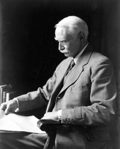William Douglas Caröe (1 September 1857 – 25 February 1938) was a British architect, particularly of churches.
William Douglas Caröe | |
|---|---|
 W. D. Caröe | |
| Born | 1 September 1857 Holmsdale, Blundellsands, Lancashire, England |
| Died | 25 February 1938 (aged 80) Kyrenia, Cyprus |
| Nationality | British |
| Occupation | Architect |
Early life
editCaröe was born on 1 September 1857 in Holmsdale, Blundellsands, near Liverpool, the youngest son of the Danish Consul in Liverpool, Anders Kruuse Caröe (d. 1897) and Jane Kirkpatrick Green (d. 1877). He was educated at Ruabon Grammar School in Denbighshire, Wales, before entering Trinity College, Cambridge in 1875.[1] He was a senior optime in the mathematical tripos of 1879[2] and graduated with a BA in the same year.[1] He was articled to John Loughborough Pearson[3] and would later write the article on Pearson in the Encyclopædia Britannica (11th ed., 1911).
Career
editCaröe was a major figure in the Arts and Crafts Movement and described as a "master of spatial painting".[4] The firm he founded, Caroe & Partners, still specialises in ecclesiastical architecture, especially the restoration of historic churches.[5]
Caröe was architect to numerous ecclesiastical buildings including St Davids and Durham cathedrals, and Tewkesbury and Romsey abbeys.[5][1] His restoration of the interior of St Lawrence's church at Stratford-sub-Castle in Wiltshire has been described as "careful".[6] Although he primarily made his name in church architecture, he was also the architect for the 1905–1909 Main Building of University College Cardiff (now Cardiff University), which was inspired by his alma mater Trinity College, Cambridge.[7]
Caröe designed additions to his country house, Vann in Hambledon, Surrey.[8] The house was featured in the TV series The Curious House Guest in 2006.
No. 1 Millbank, London, was built for the Church Commissioners in 1903.[9]
Marriage
editHe married Grace Desborough (d.1947), with whom he had two sons and a daughter. The couple's elder son was (Sir) Olaf Kirkpatric Kruuse Caröe (1892–1981), who became an Indian administrator; then came a daughter, Christian Desborough Caröe (1894–1973); and finally a second son, Alban Douglas Rendall Caröe (1904–1991), who followed his father's footsteps in architecture.
See also
editGallery
edit-
St David's Church, Exeter, 1897–1900
-
St James the Great church, Hackney: chancel by Caroe, 1902
-
Cardiff University main building, 1905–1909
-
Stoke-by-Nayland War Memorial, Suffolk, 1921
References
edit- ^ a b c "Caröe, William [Douglas] (CRW875WD)". A Cambridge Alumni Database. University of Cambridge.
- ^ MacAlister, Ian (2005). "William Douglas Caröe". Oxford Dictionary of National Biography (online ed.). Oxford University Press. doi:10.1093/ref:odnb/32298. Retrieved 16 September 2016. (Subscription or UK public library membership required.)
- ^ "Caröe, William Douglas". Who's Who. Vol. 59. 1907. p. 296.
- ^ "Charismatic Caroe". RIBA. 98 (2). 1992.
- ^ a b "About Caroe and Partners architects – history of WD Caroe – Stainburn Taylor". caroe.co.uk. Retrieved 14 September 2016.
- ^ Orbach, Julian; Pevsner, Nikolaus; Cherry, Bridget (2021). Wiltshire. The Buildings Of England. New Haven, US and London: Yale University Press. p. 681. ISBN 978-0-300-25120-3. OCLC 1201298091.
- ^ "Main Building Centenary Profile: Grand Designs". Cardiff University. Archived from the original on 28 October 2014. Retrieved 28 October 2014.
- ^ "History". Vann. Retrieved 3 May 2017.
- ^ Historic England. "THE CHURCH COMMISSIONERS, City of Westminster (1267603)". National Heritage List for England. Retrieved 3 October 2017.
Bibliography
edit- Jennifer M. Freeman (1991) W. D. Caroe: His Architectural Achievement ISBN 0-7190-2449-8
External links
edit- Caroe & Partners
- Entry in the Oxford Dictionary of National Biography